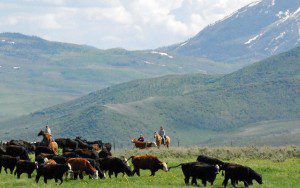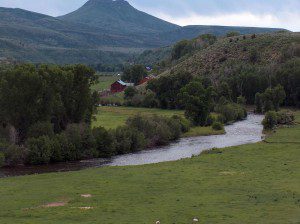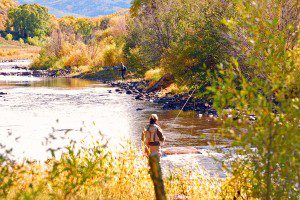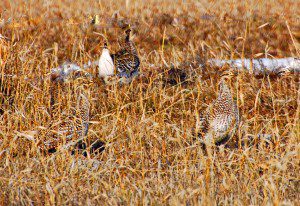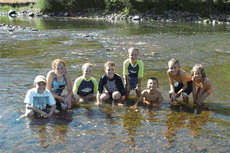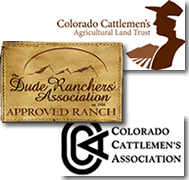Ranching for tomorrow is a big part of what drives our management plan. We believe it is our responsibility to take care of natural resources in a way to maintain them or make them better. The impact of our actions might be noticeable in our life time but the future generations will definitely benefit from those that are sustainable.
Here are a few examples of what we have accomplished and are continuing to engage in, modifying or tweaking plans as we learn.
![]()
1.Holistic Resource Management:
Our pasture rotation is based on a “holistic” management approach. We intensely graze each pasture 5 to 10 days then move to the next, allowing the pasture to re-grow. Our pasture rotation plan covers both our private land as well as our National Forest permitted pastures. Our guests enable us to practice this method of range management due to their interest in riding for a purpose. Cattle can be moved often through the pastures. By treating both our private and leased forest pastures as one and the same, we are caring for the grass, the water, control of invasive weeds, riparian areas, wildlife needs, recreational use on public lands and other issues- equally. We work in partnership with the U.S. Forest Service.
We work in partnership with the U.S. Forest Service. A grazing plan is submitted by the spring of each year. Throughout the season, the Forest Service monitors the plan as well as we propose adjustments to it when deemed necessary by actual seasonal events- drought or a late spring are examples of events that require altering the plan. In the fall, after the grazing season is over, different sites are monitored with the Forest Service, to determine the livestock and wildlife impact. It is usually at this time, future improvements on the forest pastures are discussed. These could include improving existing ponds, building new ones, control of invasive weeds, improving fences etc.
This has been a successful partnership with the U.S. Forest Service. Holistic range management has proven to be a sound agricultural practice, yielding positive results for both the resource, the land owner and the general public.
![]()
2.Conservation Easement:
Conservation easements are tailored to fit the specific landowner’s property, including differing needs and goals. We primarily worked with the
Colorado Cattleman’s Agricultural Land Trust to develop a conservation easement that will both preserve the property in perpetuity and allow us to continue our agricultural operation in a sustainable fashion. This includes the land both in Wyoming and Colorado. There were many entities involved on both the state and local level and the process took about five years. The last 12 months of the process being the most intense. The deal closed December 31st,2009. In essence, we sold the right to develop-not that we had planned to do this. However, future owners could have had we not placed an easement on the ranch. The ranch will remain as open space and can never be developed or subdivided.
![]()
3.River Restoration:
In 2007, grant money approved from the Natural Resource Conservation Services (NRCS) allowed us to begin work on our river restoration project-Phase I. Meetings were plenty with all the different entities-local and state NRCS agencies, Colorado Fish and Game Agency and contractors. The final step – the Corps of Engineers needed to approve the work and grant the permit. This was accomplished and the work began in the middle of August and completed in mid- October. Ten structures-either cross veins or j-hooks were built on a 1.5 mile stretch of the river, requiring 110 tons of large rocks. A 1.5 mile fence was built to keep livestock away from the banks of the river. The goals of the project were to stabilize the banks and improve the habitat for fish. We are satisfied with the outcomes.
Phase II of the River Restoration Project was completed in October, 2013. This was part of the project that began in 2009. From the new bridge to the end of our property on the west end, 4 j-hooks were built.
Phase III is a work in progress. The application has been filed and now we must wait for approval. If approved, it will deal with the stretch of river that lies between the above two. We would like to see this take place in the fall of 2014. Again, the goals are to stabilize the banks and improve the habitat for fish.
![]()
4.Grouse Habitat:
Focus Ranch participates in a program managed by the Natural Resource Conservation Service (NRCS) to increase Sage and Columbian Sharp Tail grouse habitat through grazing management. This plan utilizes a two pass rapid grazing model. The program requires annual submission of grazing statistics (number and type of livestock, in/out days for each pasture and percent utilization by wt.), monitoring at least one site per 1000 acres for rangeland condition and photos of monitoring sites. The monitoring plan will provide information about the rangeland response to management over time and allow for actions to maintain or improve the resource. We appreciate having an active NRCS agency in our valley. They have partnered with us on many programs to promote sustainability.


